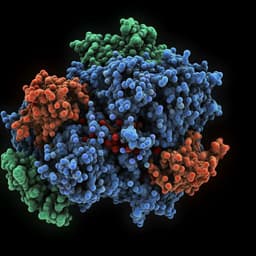
Biology
Improving prime editing with an endogenous small RNA-binding protein
J. Yan, P. Oyler-castrillo, et al.
Explore the groundbreaking findings on prime editing, a precise genome editing technique, unveiled by researchers Jun Yan and colleagues. This study identifies La, a small RNA-binding protein, as a key player in enhancing prime editing efficiency across various methods and cell types, providing insightful strategies for RNA stability.
~3 min • Beginner • English
Introduction
The study addresses why prime editing efficiency is typically low and variable and seeks cellular factors that modulate prime editing outcomes. Prime editing uses a Cas9 nickase fused to a reverse transcriptase and a prime editing guide RNA (pegRNA) to write edits without double-strand breaks. Despite its precision and versatility, editing rates are limited by cellular context, component stability, and DNA repair processes. The authors hypothesized that endogenous RNA-binding proteins might influence pegRNA function and, consequently, prime editing efficiency. They developed high-throughput reporter systems coupled with CRISPRi to perform unbiased, genome-scale screens for cellular determinants impacting prime editing, aiming to uncover mechanisms and derive strategies to enhance editing performance.
Literature Review
Prior work established prime editing (PE2/PE3) and later enhanced systems (PE4/PE5) that suppress mismatch repair to improve small substitutions. Studies highlighted factors that influence PE, including expression/localization of components and chromatin context. Engineered pegRNAs (epegRNAs) incorporating structured 3' motifs (for example, tevopreQ1, mpknot) improve performance, ostensibly by stabilizing pegRNA 3' extensions, which are prone to degradation. Other approaches include circular templates and split/tethered strategies to protect reverse transcription templates. La protein is known to bind 3' polyuridine tracts on RNA polymerase III transcripts and protect them from exonucleases. Genetic screens have mapped determinants for other CRISPR modalities (nucleases, base editors, DSB repair), but unbiased genome-scale screens for prime editing determinants had been lacking.
Methodology
- Reporter development: Built FACS-based (GFP) and magnetic cell separation (MCS; Igk–hIgG1-Fc–PDGFRB) reporters where installation of an in-frame ATG by prime editing activates reporter expression. The reporters use an SaCas9-based prime editor (SaPE2) to enable orthogonality with SpCas9 CRISPRi. Both PE2 and PE3 configurations were tested (+50 nt complementary nick for PE3).
- Genome-scale CRISPRi screens: K562 CRISPRi cells carrying the reporters were transduced with hCRISPRi-v2 library (18,905 genes, 5 sgRNAs/gene). Cells were edited (SaPE2, specific pegRNA and nicking sgRNA), sorted into reporter-positive vs -negative populations (FACS or MCS), and sgRNA enrichments were quantified by amplicon sequencing. Gene-level phenotypes were computed via CRISPhieRmix.
- Validation and functional assays: La (SSB) depletion by CRISPRi and knockout (K562 PEmax AAVS1 knock-in lines) and RNAi (HEK293T) to measure impacts on intended editing (with/without indels) across PE2/3/4/5, multiple edits (substitutions, insertions, deletions), and loci. Rescue and sufficiency tested by ectopic expression of La, mutants (S366D/G), and N-terminal domain La(1–194) with NLS fusions.
- Specificity across modalities: Compared La effects on SaCas9 nuclease, SaBE4 and SaABE8e base editors, and SaPE2 (PE4) at multiple loci using matched spacers, as well as a DSB-disruption assay at the MCS reporter.
- Synthetic pegRNA design: Generated chemically modified synthetic pegRNAs with distinct 3' end configurations: no-polyU (chemically blocked 3' ends), La-blocked (terminal 2'-OMe that abrogates La binding), and La-accessible (chemically modified upstream with unmodified terminal 2'-OH polyU). Tested editing efficiencies and La dependence.
- Small RNA sequencing: Performed small RNA-seq in K562 PEmax parental vs La-knockout cells after transfection with sets of pegRNAs/epegRNAs to assess stability and 3' end integrity (cis-active, trans-active, and inactive fragment bins).
- Editor engineering (PE7): Fused La or La(1–194) domains to PEmax at various positions; selected PEmax-C–La(1–194) construct (PE7). Assessed performance across loci (HEK293T, HeLa, U2OS), edit types, approaches (PE2/3/4/5), delivery modes (plasmid, mRNA, lentiviral), and with pegRNAs/epegRNAs and synthetic pegRNAs (La-accessible/blocked/no-polyU). Created a PE7 RNA-binding-deficient mutant (Q20A, Y23A, Y24F, F35A) for mechanism testing.
- Safety/omics: Evaluated cell viability, growth, and RNA-seq transcriptome changes after editing with PEmax, PE7, and PE7 mutant.
- Primary cells: Tested mRNA-delivered PE7 with synthetic pegRNAs in primary human CD3+ T cells and CD34+ HSPCs at disease-relevant loci (e.g., HBB, ATP1A1).
Key Findings
- Genome-scale CRISPRi screens identified 36 regulators of prime editing (FDR ≤ 0.01) with La (SSB) as the strongest positive determinant across FACS and MCS reporter screens; mismatch repair genes (MSH2, MSH6, MLH1, PMS2) validated expected roles.
- La loss impairs prime editing across PE2, PE3, PE4, and PE5, edit types (e.g., +7 GG→CA, 121-bp insertion, 21-bp insertion), loci, and cell types. Effects are stronger with pegRNAs than epegRNAs. In HEK293T siRNA experiments (PE3, 10 edits at 5 loci), median intended editing reductions were 39.7% (pegRNAs) and 19.2% (epegRNAs).
- La depletion reduces intended edits (with/without indels) but not indels alone, indicating a role in edit installation independent of mismatch repair.
- La has minimal, inconsistent effects on genome editing modalities that use standard sgRNAs (SaCas9 nuclease, SaBE4, SaABE8e); strongest and most consistent effects observed with prime editing using pegRNAs.
- Mechanism: The N-terminal RNA-binding domain La(1–194) is sufficient to promote prime editing; full-length La and S366 mutants (S366D/G) also rescue, with full-length moderately more potent than La(1–194). Synthetic pegRNA experiments show that La dependence correlates with the ability of pegRNA 3' ends to bind La: La-accessible 3' polyU with unmodified terminal 2'-OH shows strong La dependence; La-blocked terminal 2'-OMe or no-polyU pegRNAs show minimal La dependence.
- Small RNA-seq: La loss destabilizes Pol III-transcribed pegRNAs/epegRNAs, particularly at 3' ends, supporting a functional interaction with polyuridylated 3' extensions.
- PE7 editor (PEmax fused C-terminally to La(1–194)) substantially improves editing:
- Across 8 endogenous loci in U2OS cells (PE2): median 21.2-fold (pegRNAs) and 5.5-fold (epegRNAs) improvements; maintained low indels; minimal off-target increases (significant at only 2 of 13 off-target loci tested).
- Disease-relevant targets in U2OS (PE2): median 21.8-fold (pegRNAs) and 10.8-fold (epegRNAs) improvements; some cases where epegRNA with PE7 outperforms pegRNA.
- Across approaches in U2OS: median improvements in intended editing over PEmax of 7.3-fold (PE2), 7.0-fold (PE3/PE4), and 3.9-fold (PE5); PE7 with PE5 achieved 50.2% median intended editing across eight edits.
- Delivery modes: PE7 outperforms PEmax with plasmid or mRNA delivery and in lentiviral settings; Pairing PE7 mRNA with La-accessible synthetic pegRNAs outperforms PEmax with La-accessible, La-blocked, or no-polyU ends in U2OS and K562.
- Primary cells: In human T cells, La-accessible pegRNAs + PE7 mRNA achieved a median 2.3-fold improvement (median 20.0% intended editing across eight targets); in HSPCs, PE7 + La-accessible pegRNA improved HBB editing 5.2-fold and enabled 41.0% intended editing at ATP1A1 with 0.4% indels.
- Mechanism validation: Mutating La(1–194) RNA-binding residues in PE7 (Q20A, Y23A, Y24F, F35A) abolished improvements, confirming RNA-binding dependence.
- Safety/omics: PE7 caused negligible effects on cell viability, growth, and global mRNA expression relative to PEmax and the PE7 mutant (very few differentially expressed genes).
Discussion
Unbiased genome-scale CRISPRi screening revealed La as a key cellular determinant of prime editing, pointing to the importance of pegRNA 3' end biology. Functional studies demonstrate that La promotes intended edit installation, largely independent of mismatch repair effects, and that its principal activity derives from the N-terminal domain binding to 3' polyU tracts typical of Pol III-transcribed pegRNAs. Synthetic pegRNA designs that preserve an unmodified terminal 2'-OH on a polyU tail exhibit La dependence, whereas terminal 2'-OMe modifications or removal of polyU abrogate dependence. These findings, together with small RNA-seq evidence of 3' end destabilization upon La loss, suggest that La enhances prime editing by stabilizing/guarding pegRNA 3' extensions and possibly facilitating effector complex function. Translating this mechanism into engineering, fusing La(1–194) to PEmax (PE7) markedly boosts editing efficiency across loci, edit types, approaches, and delivery modalities, including in primary human T cells and HSPCs, with minimal off-target and cellular perturbation. The partial redundancy with epegRNAs and the dominance of PE7 effects indicate that recruiting La’s RNA-binding function can substitute for or complement structured 3' motifs; in many contexts, pegRNAs paired with PE7 are optimal. Collectively, these results both clarify how cellular RNA-binding proteins interface with exogenous small RNAs in prime editing and provide a generalizable strategy to improve editing outcomes.
Conclusion
This work identifies the La small RNA-binding protein as a principal positive regulator of prime editing and establishes that La’s N-terminal RNA-binding domain interacts functionally with polyuridylated pegRNA 3' ends to promote intended edits. Leveraging this, the authors engineered PE7 (PEmax–La(1–194)), which substantially increases prime editing efficiencies across multiple loci, edit classes, and approaches, and in primary human cells, with limited off-target effects and minimal impacts on cellular homeostasis. The study advances mechanistic understanding of pegRNA stability in cells and presents practical design principles: pairing PE7 with pegRNAs (including La-accessible synthetic pegRNAs) often yields optimal performance. Future efforts could refine La-accessible pegRNA design rules, optimize linkers or fusion orientations, adapt La(1–194) to compact prime editors, and explore in-trans La co-expression strategies. Broader evaluation across more cell types, delivery methods, and therapeutic settings, along with consideration of La’s immunological history in clinical contexts, are warranted.
Limitations
- Screen modality limitations: Reporter-based screens provide scalable but lower-resolution readouts; technical variability was higher in MCS-based screens, with relatively few hits and low replicate correlations, potentially missing subtle regulators.
- Mechanistic uncertainty: While data support La-mediated stabilization and 3' end interaction, the precise mechanistic steps and the quantitative relationship between pegRNA integrity and editing remain incompletely defined.
- Context dependence: Although improvements are broad, some epegRNAs with PE7 perform similarly or worse than pegRNAs; the boundaries of PE7’s benefit across diverse cell types, targets, and delivery conditions require further mapping.
- Off-target and safety scope: Off-target assessments were limited to selected known Cas9 off-targets; comprehensive genome-wide prime editing off-target profiling remains to be completed. Clinical translation must consider La’s status as an autoantigen (implications for immunogenicity).
- Affiliation/construct constraints: PE7 increases editor size; packaging/delivery constraints for certain vectors may apply.
Related Publications
Explore these studies to deepen your understanding of the subject.







